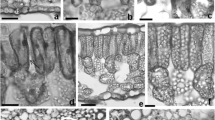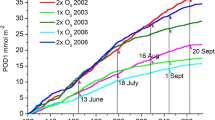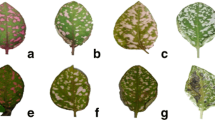Abstract
When exposed to an acute ozone stress, cell death occurred in leaves of the O3 sensitive Populus deltoides × maximowiczii clone Eridano. After treatment (5 h fumigation and 24 h recovery), the damaged areas covered more than 50 % of the leaf surface. At cellular level, these lesions were preceded by some apoptotic hallmarks and by biochemical and physiological alterations evoked by the apoplastic O3 dissociation. The cell death pattern was highly localized and involved an increase of membrane permeability, externalization of phosphatidylserine, DNA fragmentation, callose accumulation, polyphenol production, and a biphasic oxidative burst accompanied by NO overproduction. These results indicate a process of programmed cell death that could have the biological significance of limiting the spreading the oxidative burst triggered by ozone dissociation in apoplastic environment. Moreover, materials derived from cell dismantling could be remobilized toward developing structures which can conclude their ontogenetic program after the stress.
Similar content being viewed by others
Abbreviations
- CTAB:
-
cetyltrimethyl ammonium bromide
- DAF-2DA:
-
4,5-diaminofluorescein diacetate
- FITC:
-
fluoresceine isothiocyanate
- H2DCFDA:
-
2′,7′-dichlorodihydrofluorescein diacetate
- HR:
-
hypersensitive response
- MES:
-
2-(N-morpholino) ethanesulfonic acid
- PAL:
-
phenylalanineammonia lyase
- PBS:
-
phosphate-buffered saline
- PCD:
-
programmed cell death
- PI:
-
propidium iodide
- PS:
-
phosphatidylserine
- ROS:
-
reactive oxygen species
- TUNEL:
-
terminal deoxynucleotidyl transferase
- (TdT):
-
mediated dUTPnick-end labeling
References
Ahlfors, R., Brosché, M., Kangasjärvi, J.: Ozone and nitric oxide interaction in Arabidopsis thaliana. A role for ethylene? — Plant Signal. Behavior 4: 878–879, 2009a.
Ahlfors, R., Brosché, M., Kollist, H., Kangasjärvi, J.: Nitric oxide modulates ozone-induced cell death, hormone biosynthesis and gene expression in Arabidopsis thaliana. — Plant J. 58: 1–12, 2009b.
Bartoli, G., Forino, L.M.C., Tagliasacchi, A.M., Bernardi, R., Durante, M.: Ozone damage and tolerance in leaves of two poplar genotypes. — Caryologia 63: 422–434, 2010.
Bartoli, G., Forino, L.M.C., Tagliasacchi, A.M., Bernardi, R., Durante, M.: Ozone induces a HR-like response in the O3 − sensitive Populus deltoides × maximowiczii Eridano clone. — In: Proceedings of the 1st Annual Congress of Italian Society of Plant Biollogy. Pp. 52. SIBV, Verona 2009.
Bernardi, R., Nali, C., Ginestri, P., Pugliesi, C., Lorenzini, G., Durante, M.: Antioxidant enzyme isoforms on gels in two poplar clones differing in sensitivity after exposure to ozone. — Biol. Plant. 48: 41–48, 2004.
Bethke, P.C., Lonsdale, J.E., Fath, A., Jones, R.L.: Hormonally regulated programmed cell death in barley aleurone cells. — Plant Cell 11: 1033–1045, 1999.
Bird, A.P., Southern, E.M.: Use of restriction enzymes to study eukaryotic DNA methylation: I The methylation pattern in ribosomal DNA from Xenopus. — J. mol. Biol. 118: 27–47, 1978.
Cohen, G.M., Sun, X., Fearnhead, H., Macfarlane, M., Brown, D.J., Snowden, R.T., Dinsdale, D.: Formation of large molecular weight fragments of DNA is a key committed step of apoptosis in thymocytes. — J. Immunol. 153: 507–16, 1994.
Delledonne, M., Zeier, J., Marocco, A., Lamb, C.: Signal interactions between nitric oxide and reactive oxygen intermediates in the plant hypersensitive disease resistance response. — Proc. nat. Acad. Sci. USA 98: 13454–13459, 2001.
De Pinto, M.C., Tommasi, F., De Gara, L.: Changes in the antioxidant systems as part of the signalling pathway responsible for the programmed cell death activated by nitric oxide and reactive oxygen species in tobacco BY-2 cells. — Plant Physiol. 130: 698–708, 2002.
Dizengremel, P., Le Thiec, D., Hasenfratz-Sauder, M.P., Vaultier, M.N., Bagard, M., Jolivet, Y.: Metabolicdependent changes in plant cell redox power after ozone exposure. — Plant Biol. 11: 35–42, 2009.
Diara, C., Castagna, A., Baldan, B., Mensuali Sodi, A., Sahr, T., Langebartels, C., Sebastiani, L., Ranieri, A.: Differences in the kinetics and scale of signaling molecule production modulate the ozone sensitivity of hybrid poplar clones: the roles of H2O2, ethylene and salicylic acid. — New Phytol. 168: 351–364, 2005.
Di Baccio, D., Castagna, A., Paoletti, E., Sebastiani, L., Ranieri, A.: Could the differences in O3 sensitivity between two poplar clones be related to a difference in antioxidant defence and secondary metabolic response to O3 influx? — Tree Physiol. 28: 1761–1772, 2008.
Di Baccio, D., Ederli, L., Marabottini, R., Badiani, M., Francini, A., Nali, C., Antonelli, M., Santangelo, E., Sebastiani, L., Pasqualini, S.: Similar foliar lesions but opposite hormonal patterns in a tomato mutant impaired in ethylene perception and its near isogenic wild type challenged with ozone. — Environ. exp. Bot. 75: 286–297, 2012.
Doyle, J.J., Doyle, J.L.: Isolation of plant DNA from fresh tissue. — Focus 12: 13–15, 1990.
Draper, J.: Salicylate, superoxide synthesis and cell suicide in plant defence. — Trends Plant Sci. 2: 162–165, 1997.
Durante, M., Geri, C., Bonatti, S., Parenti, R.: Non-random alkylation of DNA sequences induced in vivo by chemical mutagens. — Carcinogenesis 10: 1357–1361, 1989.
Fan, T., Xing, T.: Heat shock induces programmed cell death in wheat lesions. — Biol. Plant. 48: 389–394, 2004.
Faoro, F., Iriti, M.: Cell death behind invisible symptoms: early diagnosis of ozone injury. — Biol. Plant. 49: 585–592, 2005.
Faoro, F., Iriti M.: Plant cell death and cellular alterations induced by ozone: key studies in Mediterranean conditions. — Environ. Pollut. 157: 1470–1477, 2009.
Fincher, G.B., Stone, B.A.: Metabolism of noncellulosic polysaccharides. — In: Loewus, F.A. (ed.): Encyclopedia of Plant Phisyology, New Series. Vol. 13. Pp. 68–132. Springer-Verlag, Berlin 1981.
Fiscus, E.L., Booker, F.L., Burkey, K.O.: Crop responses to ozone: uptake, modes of action, carbon assimilation and partitioning. — Plant Cell Environ. 28: 997–1011, 2005.
Gadjev, I., Stone, J.M., Gechev, T.S.: Programmed cell death in plants: new insights into redox regulation and the role of hydrogen peroxide. — Int. Rev. cell. mol. Biol. 270: 87–144, 2008.
Garces, H., Durzan, D., Pedroso, M.C.: Mechanical stress elicits nitric oxide formation and DNA fragmentation in Arabidopsis thaliana. — Ann. Bot. 87: 567–574, 2001.
Gechev, T.S., Van Breusegem, F., Stone, J.M., Denev, I., Laloi, C.: Reactive oxygen species as signals that modulate plant stress responses and programmed cell death. — Bioassays 28: 1091–1101, 2006.
Gilchrist, D.G.: Programmed cell death in plant disease: the purpose and promise of cellular suicide. — Annu. Rev. Phytopathol. 36: 393–414, 1998.
Gravano, E., Giulietti, V., Desotgiu, R., Bussotti, F., Grossoni, P., Gerosa, G., Tani, C.: Foliar response of an Ailanthus altissima clone in two sites with different levels of ozonepollution. — Environ. Pollut. 121: 137–146, 2003.
Greenberg, J.T.: Programmed cell death: a way of life for plants. — Proc. nat. Acad. Sci. USA 93: 12094–12097, 1996.
Gunawardena, A., Greenwood, J.S., Dengler, N.: Programmed cell death remodels lace plant leaf shape during development. — Plant Cell 16: 60–73, 2004.
Günthardt-Goerg, M.S., Vollenweider, P.: Linking stress with macroscopic and microscopic leaf response in trees: new diagnostic perspectives. — Environ. Pollut. 147: 467–488, 2007.
Guo, J., Li, X.F., Qi, D.M., Chen, S.Y., Li, Z.Q., Nijs, I., Li, Y.G., Liu, G.S.: Effects of ozone on wild type and transgenic tobacco. — Biol. Plant. 53: 670–676, 2009.
Havel, L., Durzan, D.J.: Apoptosis in plants. — Bot. Acta 109: 268–277, 1996.
Havel, L., Durzan, D.J.: Programmed cell death in plants development. — In: Strnad, M., Peč, P., Beck, E. (ed.): Advances in Regulation of Plant Growth and Development. Pp 203–212. Peres, Prague 1999.
Heath, R.L.: Modification of the biochemical pathways of plants induced by ozone: what are the varied routes to change? — Environ. Pollut. 155: 453–463, 2008.
Jensen W.A. (ed): Botanical Histochemistry. — W. Freeman & Co., San Francisco 1962.
Kangasjärvi, J., Jaspers, P., Kollist, H.: Signalling and cell death in ozone exposed plants. — Plant Cell Environ. 28: 1021–1036, 2005.
Koch, J.R., Creelman, R.A., Eshita, S.M., Seskar, M., Mullet, J.E., Davis, K.R.: Ozone sensitivity in hybrid poplar correlates with insensitivity to both salicylic acid and jasmonic acid. the role of programmed cell death in lesion formation. — Plant Physiol. 123: 487–496, 2000.
Kołodziejek, I., Kozioł-Lipińska, J., Wałeza, M., Korczyński, J., Mostowska, A.: Aspects of programmed cell death during early senescence of barley leaves: possible role of nitric oxide. — Protoplasma 232: 97–108, 2007.
Laloi, C., Apel, K., Danon, A.: Reactive oxygen signalling: the latest news. — Curr. Opin. Plant Biol. 7: 323–328, 2004.
Lam, E.: Controlled cell death, plant survival and development. — Nat. Rev. mol. cell. Biol. 5: 305–315, 2004.
Lamb, C., Dixon, R. A.: The oxidative burst in plant disease resistance. — Annu. Rev. Plant Physiol. Plant mol. Biol. 48: 251–275, 1997.
Lenochová, Z., Soukup, A., Votrubová, O.: Aerenchyma formation in maize roots. — Biol. Plant. 53: 263–270, 2009.
Lei, M., Podell, E.R., Baumann, P., Cech, T.R.: DNA self-recognition in the structure of Pot1 bound to telomeric single-stranded DNA. — Nature 426:198–203, 2003.
Ljubeŝić, N., Britvec, M.: Tropospheric ozone-induced structural changes in leaf mesophyll cell walls in grapevine plants. — Biologia 61: 85–90, 2006.
Lombardi, L., Ceccarelli, N., Picciarelli, P., Lorenzi, R.: DNA degradation during programmed cell death of Phaseolus coccineus. — Plant Physiol. Biochem. 45: 221–227, 2007.
Mahalingam, R., Shah, N., Scrymgeour, A., Fedorof, N.: Temporal evolution of the Arabidopsis oxidative stress response. — Plant Mol. Biol. 57: 709–730, 2005.
Mittler, R., Lam, E.: Pathogen-induced programmed cell death in tobacco. — Plant mol. Biol. 34: 209–221, 1997.
Moldau, H., Padu, E., Bichele, I.: Quantification of ozone decay and requirement for ascorbate in Phaseolus vulgaris L. mesophyll cell walls. — Phyton 37: 175–180, 1997.
Nali, C., Guidi, L., Filippi, F., Soldatini, G.F., Lorenzini, G.: Photosynthesis of two poplar clones contrasting in O3 sensitivity. — Trees 12: 196–200, 1998.
Neill, S.J., Desikan, R., Clarke, A., Hurst, R.D., Hancock, J.T.: Hydrogen peroxide and nitric oxide as signalling molecules in plants. — J. exp. Bot. 53: 1237–1247, 2002.
Nikula, S., Percy, K., Oksanen, E., Holopainen, T., Manninen, S.: Effects of elevated ozone on growth and foliar traits of European and hybrid aspen. — Boreal Environ. Res. 14: 29–47, 2009.
O’Brien, T., Mc Cully, M.E. (ed.): The Study of Plant Structure. Principles and Selected Methods. — Termacarphi, Melbourne 1981.
O’Brien, I.E.W., Reutelingsperger, C.P., Holdaway, K.M.: The use of Annexin V and TUNEL to monitor the progression of apoptosis in plants. — Cytometry 29: 28–33, 1997.
O’Brien, I.E.W., Baguley, B.C., Murray B.G., Morris B.A.M., Ferguson I.B.: Early stages of the apoptotic pathway in plant cells are reversible. — Plant J. 13: 803–814, 1998.
Overmyer, K., Brosché, M., Pellinen, R., Kuittinen, T., Tuominen, H., Ahlfors, R., Keinänen, M., Saarma, M., Scheel, D., Kangasjärvi, J.: Ozone-induced programmed cell death in the Arabidopsis radical-induced cell death 1 mutant. — Plant Physiol. 137: 1092–1104, 2005.
Pääkkönen, E., Holopainen, T., Karenlampi H.: Variation in ozone sensitivity among clones of Betula pendula and Betula pubescens. — Environ. Pollut. 95: 37–44, 1997.
Pachauri, R.K., Reisinger, A. (ed): Climate Change 2007: Synthesis Report. Contribution of Working Groups I, II and III to the Fourth Assessment Report of the Intergovernmental Panel on Climate Change. — IPCC, Geneva 2007.
Paolacci, A.R., D’Ovidio, R., Marabottini, R., Nali, C., Lorenzini, G., Abenavoli, M.R., Badiani, M.: Ozone induces a differential accumulation of phenyalanine ammonia-lyase, chalcone synthase and chalcone isomerase RNA transcripts in sensitive and resistant bean cultivars. — Aust. J. Plant Physiol. 28: 425–428, 2001.
Pasqualini, S., Piccioni, C., Reale, L., Ederli, L., Della Torre, G., Ferranti, F.: Ozone-induced cell death in tobacco cultivar Bel W3 plants. The role of programmed cell death in lesion formation. — Plant Physiol. 133: 1122–1134, 2003.
Pedroso, M.C., Magalhaes, J.R., Durzan, D.J.: A nitric oxide burst precedes apoptosis in angiosperm and gymnosperm foliar tissues. — J. exp. Bot. 51: 1027–1036, 2000.
Pennell, R.I., Lamb C.: Programmed cell death in plants. — Plant Cell 9:1157–1168, 1997.
Qiao, W., Fan, L.M.: Nitric oxide signalling in plant responses to abiotic stresses. — J. integr. Plant Biol. 50: 1238–1246, 2008.
Richet, N., Afif, D., Tozo, K., Pollet, B., Maillard, P., Huber, F., Priault, P., Banvoy, J., Gross, P., Dizengremel, P., Lapierre, C., Perré, P., Cabané, M.: Elevated CO2 and/or ozone modify lignification in the wood of poplars (Populus tremula × alba). — J. exp. Bot. 63: 4291–4301, 2012.
Rizzo, M., Bernardi, R., Salvini, M., Nali, C., Lorenzini, G., Durante, M.: Identification of differentially expressed genes induced by ozone stress in sensitive and tolerant poplar hybrids. — J. Plant Physiol. 164: 945–949, 2007.
Schraudner, M., Moeder, W., Wiese, C., Van Camp, W., Inzè, D., Langebartels, C., Sandermann, H. Jr.: Ozone-induced oxidative burst in the ozone biomonitor plant, tobacco Bel W3. — Plant J. 16: 235–245, 1998.
Singer, J., Roberts-Ems, J., Riggs, A.D.: Methylation of mouse liver DNA studied by means of the restriction enzymes msp I and hpa II. — Science 203: 1019–1021, 1979.
Strohm, M., Eiblmeier, M., Langebartels, C., Jouanin, L., Polle, A., Sandermann, H., Rennenberg, H.: Responses of transgenic poplar (Populus tremula × P. alba) overexpressing glutathione synthetase or glutathione reductase to acute ozone stress: visible injury and leaf gas exchange. — J. exp. Bot. 50: 365–374, 1999.
Tamaoki, M.: The role of phytohormone signaling in ozoneinduced cell death in plants. — Plant Signal. Behavior 3: 166–174, 2008.
Taylor, G.: Populus: Arabidopsis for forestry. Do we need a model tree? — Ann. Bot. 90: 681–689, 2002.
Vingarzan, R.: A review of surface O3 background levels and trends. — Atmos. Environ. 38: 3431–3442, 2004.
Vollenweider, P., Ottiger, M., Günthardt-Goerg, M.S.: Validation of leaf ozone symptoms in natural vegetation using microscopical methods. — Environ. Pollut. 124: 101–118, 2003.
Wang, Y., Lin, J.S., Wang, G.X.: Role of calcium in nitric oxide-induced programmed cell death in tobacco protoplasts. — Biol. Plant. 54: 471–476, 2010.
Wohlgemuth, H., Mittelstrass, K., Kschieschan, S., Bender, J., Weigel, H.J., Overmyer, K., Kangasjärvi, J., Sandermann, H., Langebartels, C.: Activation of an oxidative burst is a general feature of sensitive plants exposed to the air pollutant ozone. — Plant Cell Environ. 25: 717–726, 2002.
Xie, Q.E., Liu, I.D., Yu, S.X., Wang, R.F., Fan, Z.X., Wang, Y.G., Shen, F.F.: Detection of DNA ladder during cotyledon senescence in cotton. — Biol. Plant. 52: 654–659, 2008.
Xu, C.J., Chen, K.S., Ferguson, I.B.: Programmed cell death feature in apple suspension cells under low oxygen culture. — J. Zhejiang Univ. Sci. 5: 137–143, 2004.
Xu, P., Roossinck, M. J.: Cucumber mosaic virus D satellite RNA-induced programmed cell death in tomato. — Plant Cell 12:1079–92, 2000.
Author information
Authors and Affiliations
Corresponding author
Additional information
Acknowledgements: The authors thank Prof. A. Ranieri and Dr. A. Castagna (Department of Agriculture, Food and Environment, University of Pisa) for ozone fumigation apparatus providing and for the assistance during the fumigation treatment of poplar rooted-cuttings.
Rights and permissions
About this article
Cite this article
Bartoli, G., Forino, L.M.C., Tagliasacchi, A.M. et al. Cell death induced by ozone stress in the leaves of Populus deltoides × maximowiczii . Biol Plant 57, 514–524 (2013). https://doi.org/10.1007/s10535-013-0315-3
Received:
Accepted:
Published:
Issue Date:
DOI: https://doi.org/10.1007/s10535-013-0315-3




